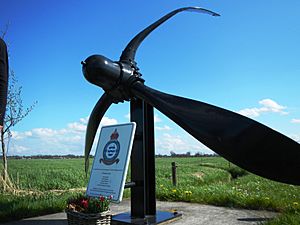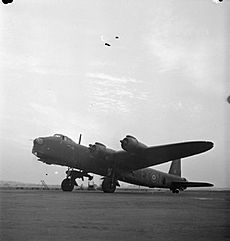No. 199 Squadron RAF facts for kids
Quick facts for kids No. 199 Squadron RAF |
|
|---|---|
| Active | 1917-1919 1942-1945 1951-1958 |
| Country | |
| Branch | |
| Motto(s) | "Let tyrants tremble" |
No. 199 Squadron was a special group of planes and pilots in the Royal Air Force (RAF). They flew during World War II and also in the 1950s. Their main job was to use special equipment to confuse enemy radar.
Contents
History of No. 199 Squadron
Early Days: World War I Training
No. 199 Squadron first started on June 1, 1917, in a place called Rochford. Back then, they used planes called Royal Aircraft Factory BE.2e biplanes. Their mission was to teach pilots how to fly advanced bomber planes.
Later, in 1918, the squadron's name changed to No. 99 (Depot Training) Squadron RFC. They moved to RFCS Harpswell, Lincolnshire. Here, they trained pilots for night bombing missions. The squadron was then closed down on June 13, 1919.
World War II: From Bombers to Jamming
The squadron started up again on November 7, 1942, at RAF Blyton. This time, they flew Vickers Wellington planes. After a few months, they moved to RAF Lakenheath. There, they got new, bigger planes called Short Stirling heavy-bombers.
Between February and June 1943, the squadron was based at RAF Ingham in Lincolnshire. They practiced laying mines in the sea, especially over The Wash. After this training, they went back to RAF Lakenheath. They then started flying missions over the English Channel and the North Sea.
In July 1943, the squadron began dropping mines using their Stirling planes. From February 1944, they also started dropping supplies for the Special Operations Executive. This group helped secret agents and resistance fighters.
In May 1944, No. 199 Squadron joined No. 100 (Radio Countermeasures) Group. Their new job was to jam enemy radar during the D-Day landings. This meant they used special equipment to confuse German radar systems. This made it harder for the Germans to see Allied planes and ships.
The squadron's planes also joined big bombing raids over Germany. But they had advanced radar jamming gear to mess up German air defenses. In 1945, the Stirlings were swapped for Handley Page Halifax planes. The squadron was then closed down on July 29, 1945, at RAF North Creake.
The 1950s: Electronic Warfare
In 1951, the squadron was formed again at RAF Watton. They became part of No. 90 Signals Group. Their new role was electronic countermeasures. This meant they used electronic signals to trick or block enemy systems. They flew Avro Lincoln and de Havilland Mosquito planes.
The Mosquitos were later replaced by English Electric Canberra planes. The squadron worked with other Canberra squadrons at RAF Hemswell. In 1957, the Lincolns were replaced by Vickers Valiant planes. The squadron was finally closed down on December 15, 1958. The Valiant planes from C Flight became part of 18 Squadron at RAF Finningley.
Aircraft Operated by No. 199 Squadron
| Dates | Aircraft | Variant |
|---|---|---|
| 1917–1919 | Royal Aircraft Factory B.E.2 | BE.2e |
| 1942–1943 | Vickers Wellington | III and X |
| 1943–1945 | Short Stirling | III |
| 1945 | Handley Page Halifax | III |
| 1951–1957 | Avro Lincoln | B2 |
| 1952–1953 | de Havilland Mosquito | NF36 |
| 1954–1958 | English Electric Canberra | B2 |
| 1957–1958 | Vickers Valiant | B1 |



